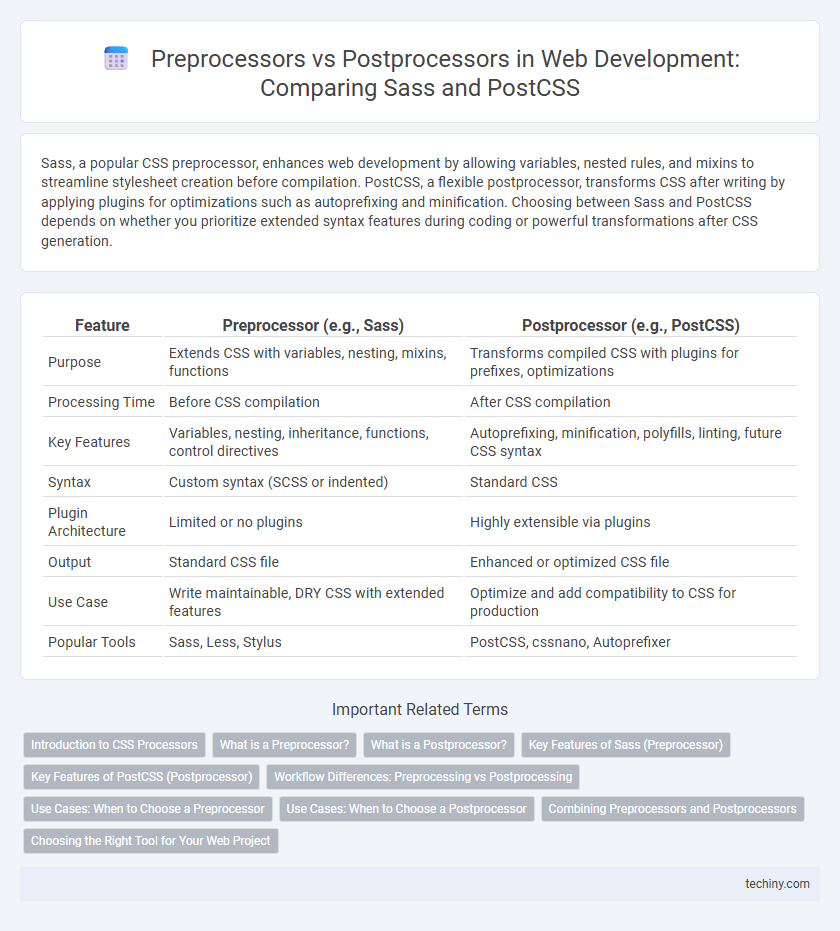Sass, a popular CSS preprocessor, enhances web development by allowing variables, nested rules, and mixins to streamline stylesheet creation before compilation. PostCSS, a flexible postprocessor, transforms CSS after writing by applying plugins for optimizations such as autoprefixing and minification. Choosing between Sass and PostCSS depends on whether you prioritize extended syntax features during coding or powerful transformations after CSS generation.
Table of Comparison
| Feature | Preprocessor (e.g., Sass) | Postprocessor (e.g., PostCSS) |
|---|---|---|
| Purpose | Extends CSS with variables, nesting, mixins, functions | Transforms compiled CSS with plugins for prefixes, optimizations |
| Processing Time | Before CSS compilation | After CSS compilation |
| Key Features | Variables, nesting, inheritance, functions, control directives | Autoprefixing, minification, polyfills, linting, future CSS syntax |
| Syntax | Custom syntax (SCSS or indented) | Standard CSS |
| Plugin Architecture | Limited or no plugins | Highly extensible via plugins |
| Output | Standard CSS file | Enhanced or optimized CSS file |
| Use Case | Write maintainable, DRY CSS with extended features | Optimize and add compatibility to CSS for production |
| Popular Tools | Sass, Less, Stylus | PostCSS, cssnano, Autoprefixer |
Introduction to CSS Processors
CSS processors enhance stylesheet management by automating repetitive tasks and improving code maintainability. Preprocessors like Sass enable developers to use variables, nested rules, and functions, compiling into standard CSS before deployment. Postprocessors such as PostCSS transform CSS after compilation, optimizing output by adding vendor prefixes and enabling advanced plugins for better browser compatibility and performance.
What is a Preprocessor?
A preprocessor like Sass transforms extended CSS syntax, including variables, nested rules, and mixins, into standard CSS before the browser processes it, enhancing maintainability and modularity. It allows developers to write more dynamic and reusable stylesheets by compiling code during the build process. This compilation step ensures compatibility across browsers by converting advanced features into vanilla CSS understood universally.
What is a Postprocessor?
A postprocessor in web development is a tool that processes CSS code after it has been written or compiled, optimizing and transforming it for better browser compatibility and performance. PostCSS, a popular postprocessor, uses plugins to automate tasks like autoprefixing, minification, and polyfilling CSS features. Unlike preprocessors such as Sass, which extend CSS with variables and functions before compilation, postprocessors focus on enhancing existing CSS for production environments.
Key Features of Sass (Preprocessor)
Sass enhances CSS with variables, nested rules, and mixins that streamline code reuse and maintainability in web development. Its preprocessing capabilities compile Sass syntax into standard CSS, improving workflow efficiency and enabling modular stylesheet architecture. Features like functions and control directives empower developers to write dynamic, scalable stylesheets tailored for complex projects.
Key Features of PostCSS (Postprocessor)
PostCSS is a powerful postprocessor that processes CSS using JavaScript plugins to enhance style sheets with features like autoprefixing, linting, and minification. It allows for flexible customization through a wide range of plugins, enabling developers to automate tasks such as adding vendor prefixes, optimizing CSS output, and enforcing coding standards. By operating after the CSS is compiled, PostCSS improves maintainability and performance without modifying the original source syntax like preprocessors do.
Workflow Differences: Preprocessing vs Postprocessing
Preprocessing with tools like Sass involves writing enhanced CSS syntax that compiles into standard CSS before deployment, enabling features such as variables, nesting, and mixins for more efficient stylesheet management. Postprocessing with PostCSS occurs after the CSS is compiled, transforming the CSS output by applying plugins that optimize performance, add vendor prefixes, and enforce coding standards, enhancing compatibility and maintainability. The workflow difference lies in Sass improving the authoring phase, while PostCSS focuses on refining the final CSS output for production environments.
Use Cases: When to Choose a Preprocessor
Preprocessors like Sass are ideal for projects requiring advanced features such as variables, nested rules, and mixins to streamline CSS development and maintainability. They excel in large-scale applications where modular and reusable stylesheets improve workflow efficiency. Choosing a preprocessor is beneficial when developers need enhanced functionality beyond standard CSS to simplify complex styling tasks.
Use Cases: When to Choose a Postprocessor
Postprocessors like PostCSS are ideal when enhancing maintainability and enabling CSS transformations that integrate with modern workflows such as autoprefixing, linting, and minification. They excel in projects requiring compatibility optimization across different browsers or when applying plugin-based features without changing the original CSS syntax. Postprocessors fit best in environments that prioritize modular CSS architecture and automated performance improvements.
Combining Preprocessors and Postprocessors
Combining preprocessors like Sass with postprocessors such as PostCSS enhances CSS workflow by leveraging Sass's advanced features like variables and nesting alongside PostCSS's powerful plugins for autoprefixing and optimization. This integration streamlines stylesheet management, improves browser compatibility, and automates tasks such as minification and linting. Adopting both tools maximizes efficiency and maintains clean, scalable, and performant CSS codebases in modern web development.
Choosing the Right Tool for Your Web Project
Choosing between Sass and PostCSS depends on your project's needs, workflow, and team expertise. Sass offers powerful features like variables, nesting, and mixins for streamlined CSS authoring, ideal for larger projects requiring maintainable and reusable styles. PostCSS excels in flexibility by enabling custom plugin integration to optimize, autoprefix, and transform CSS, making it suitable for projects prioritizing performance and future-proofing.
Preprocessor vs Postprocessor (e.g., Sass vs PostCSS) Infographic

 techiny.com
techiny.com